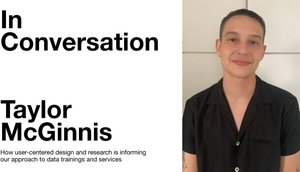In Conversation with Taylor McGinnis

Former Pratt Center Fellow Taylor McGinnis rejoined our team last month as Democratizing Data Researcher after serving for three years as a programmer and product manager at NYC Planning Labs. In a conversation in May of 2021 with Pratt Center’s Ben Dodd, she shared about how a user-centered approach is guiding her research and the development of new data training curriculum for Pratt Center. The interview below has been lightly edited for brevity.
Ben Dodd:
Can you start out by sharing a little about your journey towards data.
Taylor McGinnis:
I got into this work intending to become a GIS expert or cartographer. I finished the 1-year GIS and design certificate program through Pratt SAVI in 2018, and it really shifted the direction I was going. The classes were really affordable and the program included free workshops on building an online portfolio, which helped me get internships with Pratt Center, where I worked on map based resources to help groups make more informed planning decisions, and after that, NYC Planning Labs, where I did more software engineering and building open data tools that were really interactive.
After the Planning Labs internship, I spent three years on staff there, and more than any of the technical skills, what I really took away from the experience was the user-centered approach to research and design—how to effectively incorporate data into real world decisions, how to understand an audience and how to speak to them through building resources and tools. It’s about not making assumptions, and seeking to understand both your audience and the data and how the data connects to the audience.
This was really unique for a government setting, which tend to stick with conventional methods and routes of doing things, and that’s partly because it’s harder to get resources in government than in the private sector. So Planning Labs was an attempt to bring together a government approach—in terms of making data open and public—and the software development world—with really innovative team dynamics, agile methods, flexibility, and making sure you're not just going down a road because you were already going down it. We used a lot of the methods that are included in the scrum framework, which is an approach to user centered design that focuses on making sure your team is always aiming to improve from your last project, constantly trying to change and shift how you're thinking about things.
BD:
In your role as a data researcher and developer, what skills do you call upon the most?
TM:
Hard skills are definitely valuable, and I know basic software development like html, javascript, and CSS. I’ve learned different frameworks like ember and also about building and managing databases and deploying web applications.
But I must admit, I think the soft skills are more important, the part of my brain that makes connections is the first thing I think about. When you’re trying to understand data you have to be constantly making connections between things that seem related and things that seem unrelated. You cannot ignore any piece of evidence that comes up, you always have to be asking the right questions.
Yes, I know the programming language sql and that's useful, but I can go online and reread an article on sql and know how to employ that programming language. I think what gets overlooked is making sure you are paying attention to the details, while also zooming out to see the full picture. Often people are so focused on the numbers that they ignore the real world context, which is often even more important than the data.
I remember hearing about an example where a city had done a study exploring how creating a new park would change the quality of life of the people around it. Nevermind that “quality of life” could have included anything. They built the park and then said look at all this data that’s changed. Look at how quality of life has improved. But it turns out the new park had displaced the people living around it, because the rent prices had gone up. So the data they were looking at was associated with people who had moved in and displaced the original residents. So you can focus on the data, but you have to constantly be zooming in and zooming out and trying to make connections. I'm always drawing diagrams and webs on my scratch paper because I'm very visual so that's how I like to think about things.
BD: Can you talk about the approach you’re taking to our democratizing data work at Pratt Center?
TM:
I'm taking a no assumptions approach, starting from scratch. If I don't have evidence to make a decision, I'm not going to make that decision. Right now I'm mainly focusing on understanding the audience of organizations that Pratt Center serves.
I’m also trying to understand the overall landscape of New York City data—not what I thought I knew about the scene in 2018— but what it’s like today and what's changed, and not answering any questions before I've had the chance to look at the external world.
I am taking a lot of methods that are similar to what software development companies use in terms of user research and user centered design, and I'm trying to merge those methods with a community based approach, a public resource approach. Those software development methods help with productivity and getting things done, but they also help with understanding your users/audience.
So, no assumptions, audience-centered, and then the hard skills will come into play, but only after I've understood the real world context. So it's kind of a step by step process and all the steps overlap in different ways.